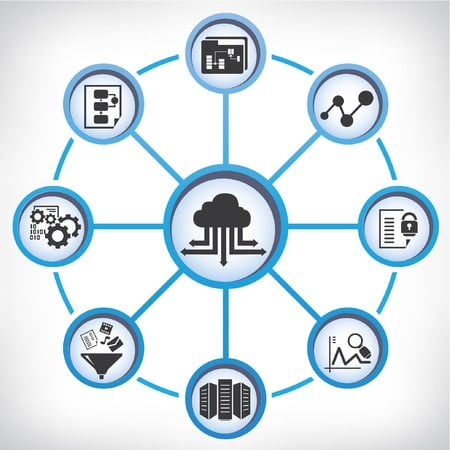What is the employee experience and customer experience ROI connection? Let’s take a look at all the players and definitions.
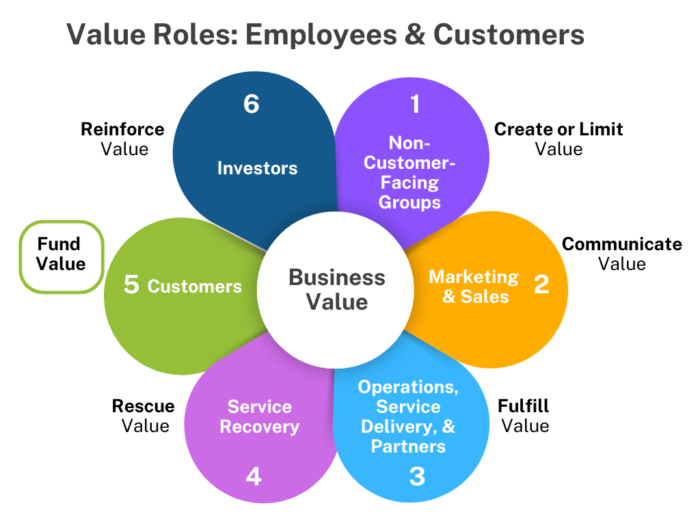
Business value is:
— Created primarily by ALL non-customer-facing employees and suppliers.
— Communicated by Marketing and Sales employees.
— Fulfilled by Operations and Service Delivery employees and partners.
— Rescued by Service Recovery employees.
— Paid for by customers.
— Reinforced by investors.
EVERY employee and partner is vital to efficient and effective customer value.
Follow the money!
— Customers fund your salaries, budgets, and profit-sharing.
— When customers leave: investors leave, partners leave, and employees leave.
— Investors rely on your customers, employees, and partners for value.
Without customers, nobody progresses.
Note: This implies customer experience context as indisputable top priority for growth-generating employee experience design that makes everyone happy.
Table of Contents
This is a comprehensive yet concise handbook chapter with many diagrams and minimal reading.
1. Employee Engagement Affects Everyone’s Value
— A. Cost of Disengagement
— B. Benefits of Engagement
— C. Negative Trends
— D. Expensive for Customers
— E. Lower Quality for Customers
— F. Lower Trust in Business
— G. Huge Revenue Lost
2. How You Run Your Business IS Employee Experience, Customer Experience, and Investor Growth
— A. Expectations
— B. High Potential
— C. North Star
— D. Internal Interaction
— E. Voice of Experience
— F. Innovation
— G. Governance
— H. Community
3. Keys to Employee Experience ROI
— A. Supervisors
— B. Purpose
— C. Nimble Resilience
— D. HR Infrastructure
Employee Engagement Affects Everyone’s Value
A. Costs of Disengagement:
$8.8 trillion, or 9% of global GDP is the worldwide cost of poor management and lost productivity from Not Engaged or Actively Disengaged employees, according to Gallup in May 2024.1
Actively Disengaged Employees = 18% of employees worldwide:2
“Resentful that their needs aren’t being met and acting out their unhappiness. Every day, these workers potentially undermine what their engaged coworkers accomplish.”3
Not Engaged Employees = 59% of employees worldwide:2
“Putting time — but not energy or passion — into their work.”3
How big is $8.8 trillion? These gold boxes show countries’ combined equivalent GDP.4
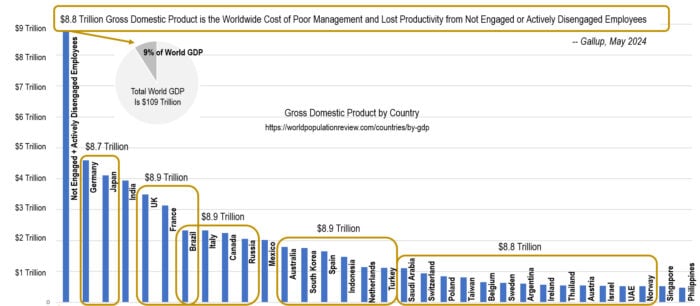
(Gross Domestic Product is final end-user’s spending on all goods and services produced by a specific country.)
B. Benefits of Engagement:
23% of employees worldwide are thriving at work
Thriving = Engaged Employees = 23% of employees worldwide:2
“Proud of the work they do and take ownership of their performance, going the extra mile for teammates and customers.”)2
Top-engaging organizations have 70% engaged employees in the U.S., with a ratio of 14-to-1 Engaged versus Actively Disengaged employees.
— This is 7X the U.S. average of 1.8-to-1 ratio.
— Top-performers span a range of industries and geographies with strategically planned, intentional, inspiring workplace cultures.5
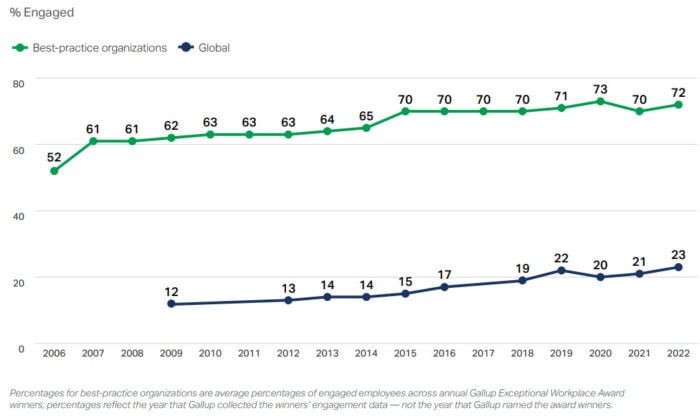
Top- versus bottom-quartile firms reveal advantages of engaged employees:3
17% higher sales
23% higher profit
10% higher customer engagement
30% fewer defects
63% fewer accidents
26% less theft
78% less absenteeism
51% fewer exits in low-turnover orgs
21% fewer exits in high-turnover orgs
Biggest increase year-over-year in employee engagement: India 10%, China 9%, and Egypt 6%.6
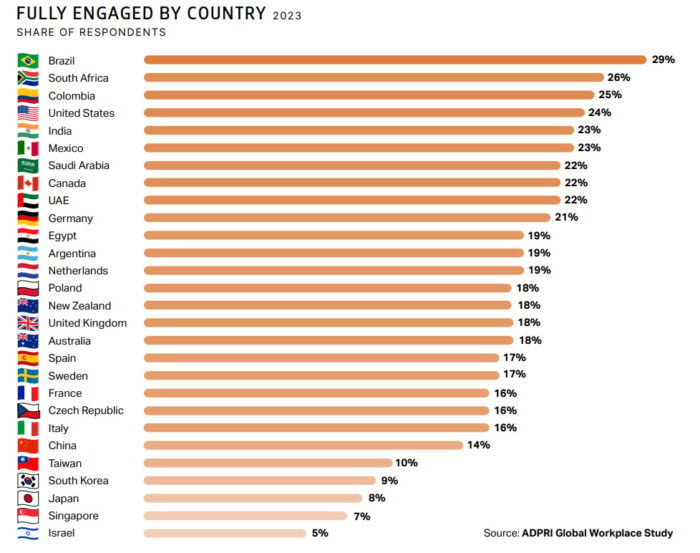
58% of tech workers and 78% of health care workers are NOT very motivated.7

C. Negative Trends:
Employee motivation dropped in 2023 to the same level as end-2021.7

Engagement peaked in 2020, declining in the U.S. now to 9.6 million fewer workers engaged.3
4.8 million fewer U.S. employees are engaged in early 2024 compared to 2023.3
1.6-to-1 Engaged versus Actively Disengaged employees in the first quarter of 2024 is the lowest ratio since 2013.3
D. Expensive for Customers:
Prices rose 20.8% since February 2020.8
Today, $1,208 buys the same goods and services that cost $1,000 in early 2020.8
Complications include interest rates and saving for emergencies and investing for retirement.8
For many people, wage gains outpaced inflation.9 However, among retirees, disabled workers, and the gig economy, keep in mind that many consumers and B2B customers do not have income beyond cost-of-living (inflation) increases or a salary at all or dependable wages.
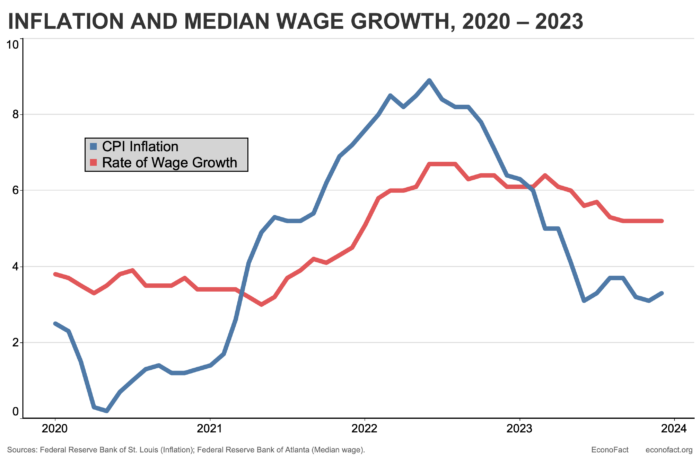
E. Lower Quality for Customers:
“The quality of customer experience has been mostly flat in the last few years, with 2024 seeing a further decline,” said Riccardo Pasto, about the 2024 Forrester CX Index.10
“Companies are struggling to deliver great CX at scale. Customer expectations constantly increase,” said Pete Jacques, Forrester Principal Analyst.11 To-date, no industry has ever scored in the Excellent or Good category of the CX Index. All industry scores are in the OK or Poor category, with none in the Very Poor category. Only 1 company has scored in the Good category: USAA.12
F. Lower Trust in Business:
“Consumer trust has deteriorated to levels last seen in 2016,” reported Qualtrics in January 2024. “After dipping to a low of 45% in 2020, consumer trust has yet to recover to pre-pandemic levels and has sat at 50% for the past two years.”13
Consumers’ priorities are:14
1. Good products/services.
2. Good customer support.
3. Easy-to-use website/app.
4. Do good things for society.
Customer trust across industries, purchase contexts, and buyer ranks is based on:15
1. Competence (top importance to 30% of U.S. buyers and 46% of Europe buyers)
2. Dependability (top importance to 19% of U.S. buyers and 25% of Europe buyers)
3. Consistency (top importance to 17% of U.S. buyers and 23% of Europe buyers)
Other customer trust factors in businesses: accountability, empathy, integrity, and transparency.
Nearly two-thirds of global business purchase influencers who trust a company will pay a premium to work with that company, and 83% would recommend the company to others externally.14
Only 6% of U.S. companies are customer-obsessed, according to Forrester’s 2023 CX Index report.10 The 4 winners of Forrester’s 2024 Customer Obsession Awards are Prudential, Albertsons, and T-Mobile in North America16 and Nedbank Retail & Business Banking in Europe, Middle East, and Africa.
“Nedbank Retail and Business Banking is a prime example of how, by nurturing a customer-centric culture that puts customers at the centre of leadership, strategy, and operations, businesses can drive growth, profitability, customer retention, and employee engagement,” said Martin Gill, VP & Research Director at Forrester and host of CX Summit EMEA.17
44% of customers do not trust publicly-traded companies to do what is right, according to the 2024 Edelman Trust Barometer. (To clarify, on a scale of 1 to 9, only 56% of people in 22 countries provided a 6, 7, 8, or 9 rating to the question: How much do you trust publicly-traded companies to do what is right? The remaining 44% provided a rating between 1-5 on the 9-point scale.)18
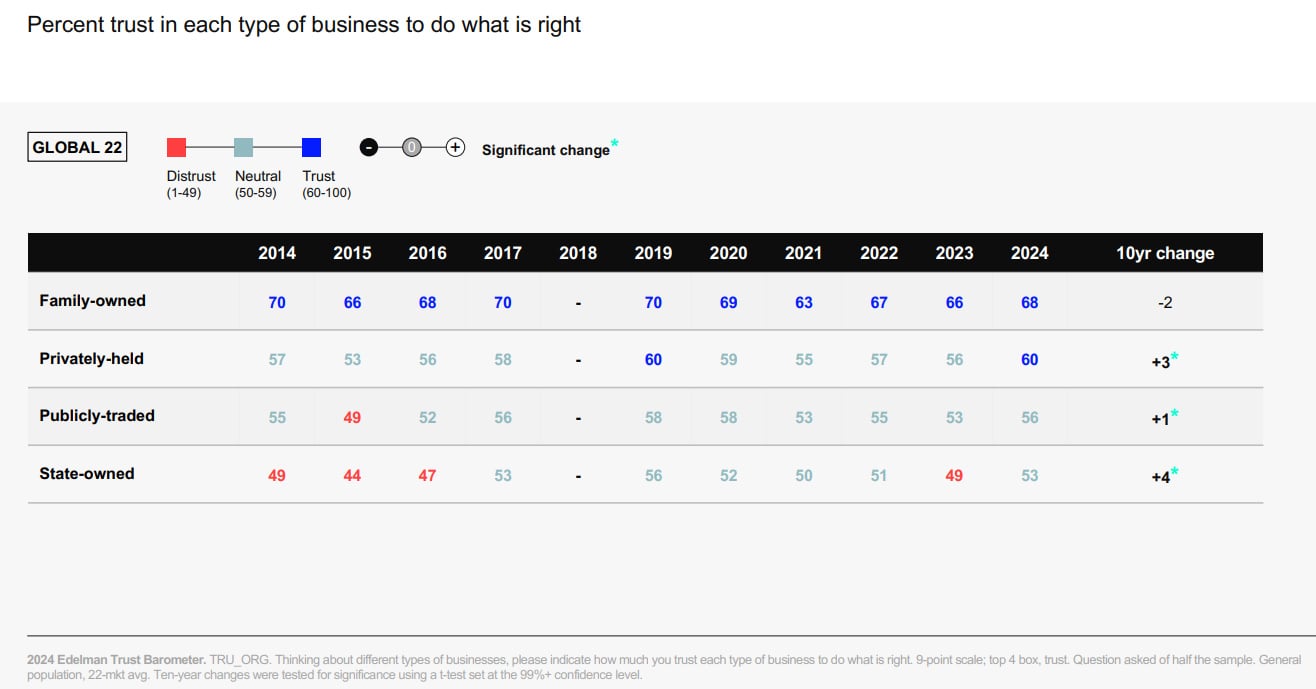
Trust has not improved meaningfully over the past 10 years in family-owned, privately-held, publicly-traded or state-owned business, despite significant investments in employee experience and customer experience technologies since the global economic crisis of 2009.18
Trustful engagement of employees and customers is less sustained by technologies (quick wins) and most sustained by customer-centered management of your business (enduring wins).
G. Huge Revenue Loss:
$3.7 trillion of sales is at risk from bad experiences in 2024. As customers now are reacting more severely to poor experiences, this risk rose from $3.1 trillion in 2023.19
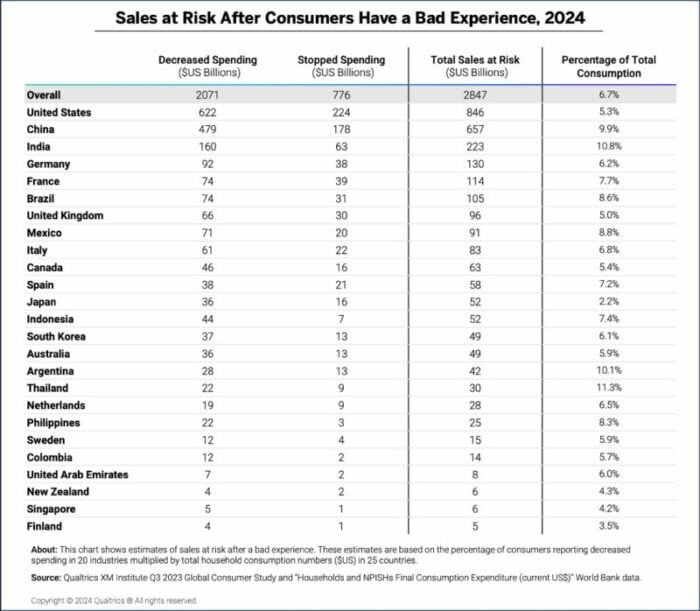

How You Run Your Business IS Employee Experience, Customer Experience, and Investor Growth
Let’s face the facts:
— Employee and customer experience trends align.
— Both are very immature.
— Enticing engagement of customers or employees, alongside business-as-usual, is hurting investor growth and quality of life for billions of people.
Status quo is too expensive.
It’s time for new ways.
Investor experience is shaped by the convergence of customer experience (CX), employee experience (EX), and partner experience (PX). You rely on these 3 parties to run your business.
How you run the business is CX, EX and PX.
They’re intertwined. Siloed approaches for any of these cause havoc and immense lost opportunities.
Here’s a new way to synchronize for maximum growth. It’s your how-to guide for “nurturing a customer-centric culture that puts customers at the center of leadership, strategy, and operations, businesses to drive growth, profitability, customer retention, and employee engagement” as discussed in the trust section above.
Read this diagram clockwise, starting from the upper right corner:
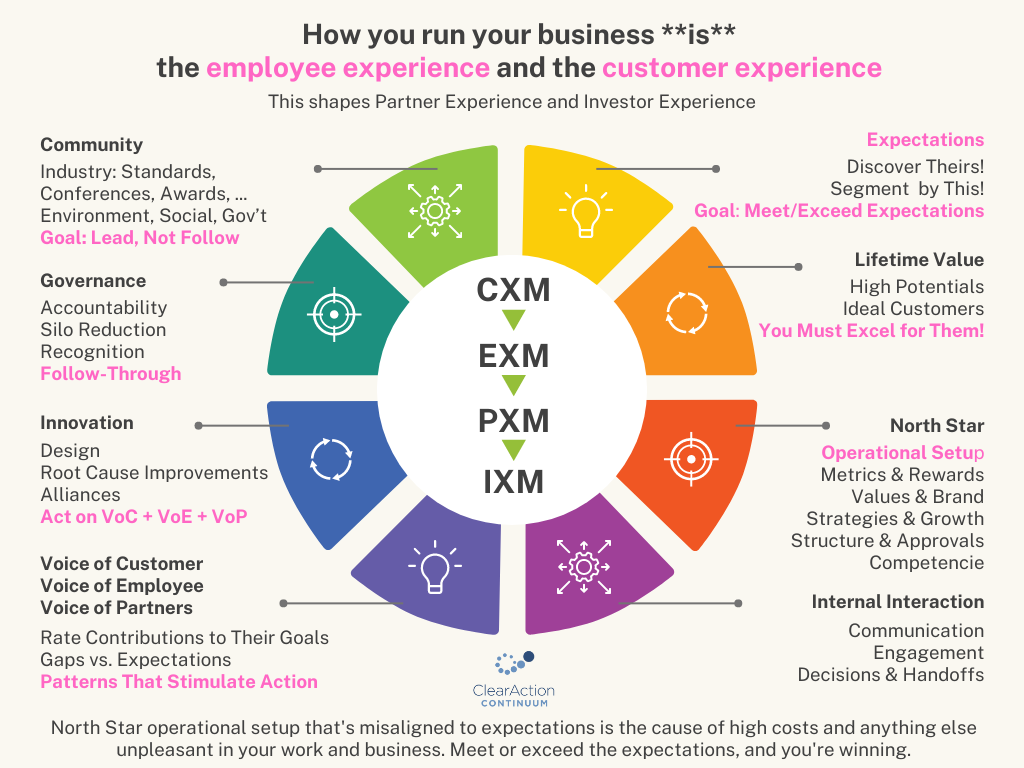
A. Expectations
How well are we meeting their expectations? What are their expectations?
Meeting or exceeding their expectations is how you win.
— Discover this by mining what you have.
— See what themes surface without bias.
— Then ask them clarifying questions.
— Create a hierarchy of (1) customer expectations as context for (2) employee expectations, which forms the context for (3) partner expectations, and then for (4) investor expectations. This hierarchy is the consensus of CEOs of the Business Roundtable.
— Find commonalities across each tier.
— Segment by their expectation themes.
— Simplify to avoid temptation to be all things to all parties. By distilling commonalities to 2-3 themes total, you empower non-customer-facing roles and your business ecosystem to align to customers, employees, and partners.
Use expectations segments as your top lens for vision, purpose, and performance standards.
When leaders take the time to understand an employee’s role, career aspirations, and perspectives, likelihood increases for employees to:20
Feel a strong connection with their leader by 7X.
Feel a sense of belonging at work by 3X.
Rate their workplace community as strong by 3X.
Feel a sense of fulfillment in their work by 2X.
Have above-average engagement by 2X.
B. High Potential
What are priorities of high-potential customers, employees, and partners?
You must excel with them for growth and continuity.
Re-think core-growth customers at the intersection of most lucrative revenue potential and low cost to serve.
C. North Star
How aligned are you to high-potentials’ priorities?
Fully aligned operational setup minimizes waste and maximizes gains.
Synchronize with their priorities:
— Metrics and rewards of all kinds.
— Values and brand.
— All strategies and growth efforts.
— Structure and approval policies.
— Competencies of people, processes.
D. Internal Interaction
How do high-potentials want to feel?
Degree of congruence internally is transparent externally.
Model from the top appropriate style and standards of communication, engagement, decisions, and handoffs.
North Star operational setup and internal interactions that are misaligned to expectations are the cause of high costs and anything else unpleasant in your work life and business performance.
Lack of clarity is the top gap between strategy and execution:
Half of the C-suite struggles with connecting the dots accurately.
Less than a third of senior execs’ direct reports get it right.
Just 16% of customer-facing supervisors and team leaders successfully identify the relationships between corporate priorities and objectives.
Employees are more likely to believe their organizations care about them when:20
Communication happened early: 7.5X.
Communication was frequent: 7X.
Communication was clear: 10X.
Communication felt honest: 10X.

E. Voice of Experience (VoX)
What’s new in expectations and in performance gaps?
Data informs managers and patterns inspire managers.
Balance expectations research and performance validation research.
Emphasize patterns to elevate creativity, differentiation, and growth rate.
Most employees expect to give input and help guide planning. 7
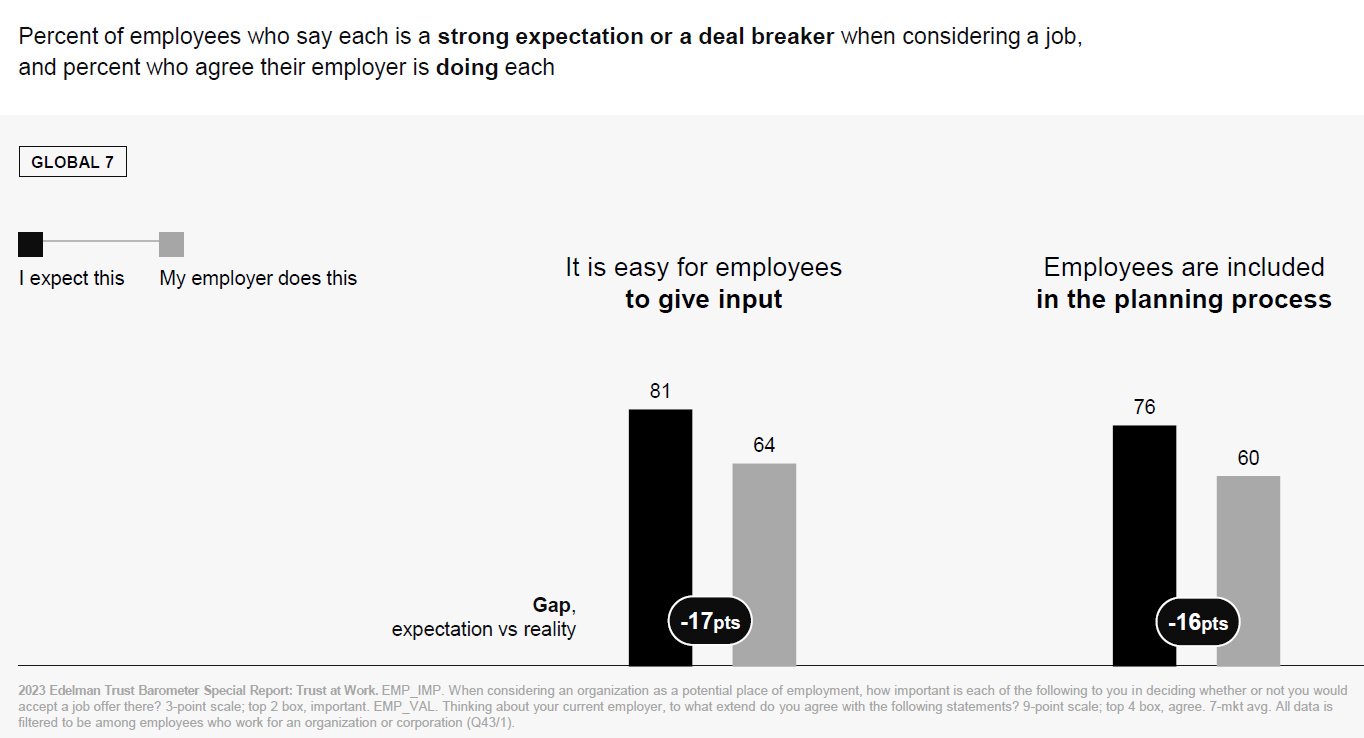
When organizations solicit, use, and acknowledge feedback, employees are less likely to feel anxious and more likely to stay.
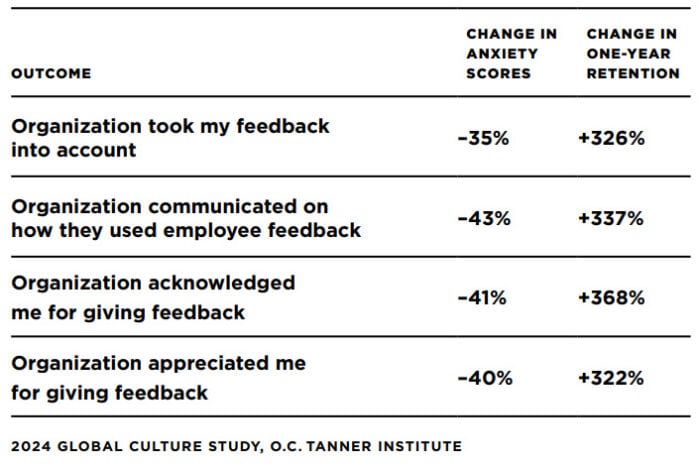
F. Innovation
Drive urgency in closing gaps.
Act on VoX as lifeblood of your enterprise.
Monitor insights usage rate across organizations, growth efforts, efficiency efforts, business management, experience management, and allies.
Close gaps at the root causes and nurture agile culture in design of all processes, policies, alliances, efficiencies, and opportunities.
Course-correct deviations from high-potentials’ expectations and priorities.
Most employees want their work to shape the future in a meaningful way, according to the Trust at Work study by Edelman7.
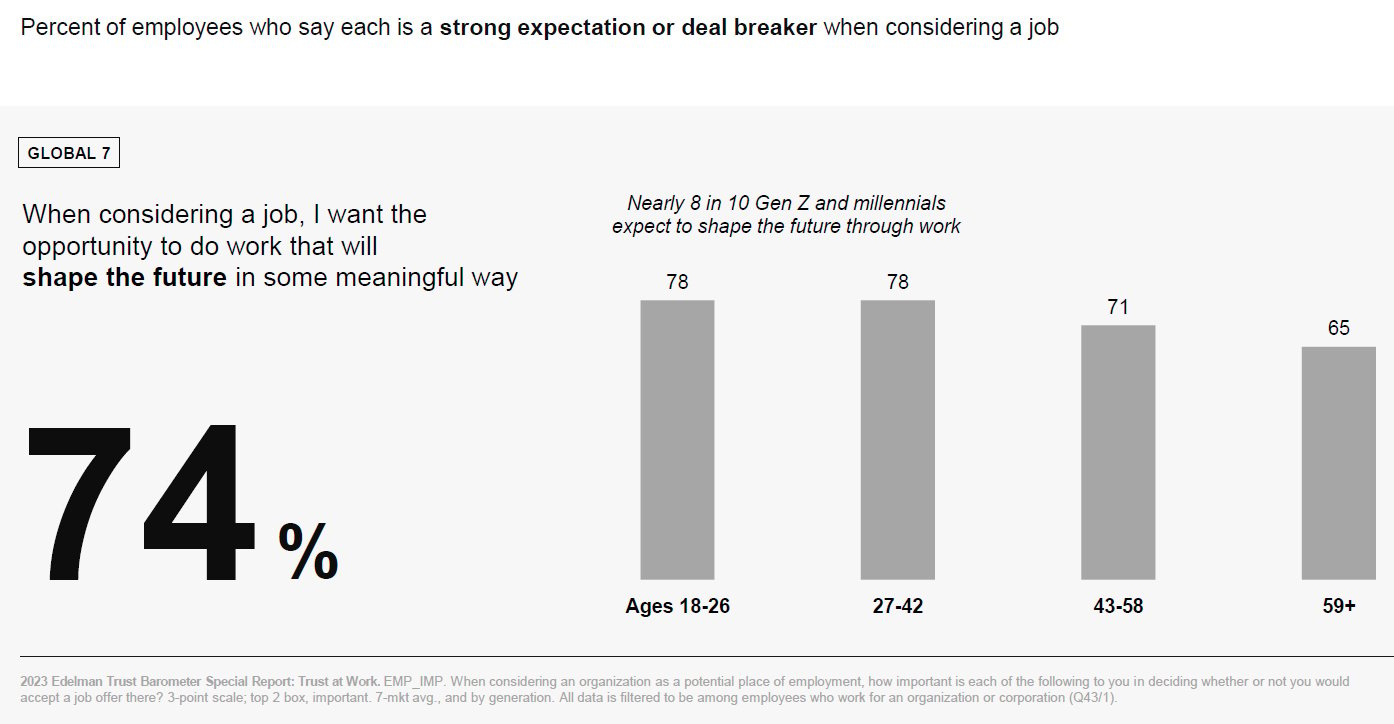
When employees have a voice in organizational changes, there are greater odds of:20
Belief the organization is people-centric by 8X.
Feelings of trust by 8X.
Sense of community by 5X.
Thriving at work by 3X.
G. Governance
Celebrate integrity.
Follow-through strengthens trust and relationship value.
Minimize silos of all types.
Recognize progress generously and equitably. Good reinforces good.
H. Community
Elevate your industry and communities.
Leapfrog norms to drive maturity in customer, employee, and business value.
Maintain harmony with your high-potentials’ expectations and priorities in your contributions to industry standards, conferences and awards, environmental and social performance, and government relations.
Repeat this wheel (steps A-H) as you refresh your strategic planning, or as often as forces cause potential expectations changes for customers, employees, and/or partners.
Keys to Employee Experience ROI
70% of engagement relies on their manager.1 Employee experience is shaped most by supervisors, and then by colleagues, senior leadership, and Human Resources infrastructure. Greatest value in employee experience design: guiding supervisors at every managerial level in (a) modern drivers of engagement, (b) customer trust factors, (c) closing the gaps as employees see things, and (d) aligning employees with work they love.
Supervisor gaps are in the bottom quadrants of this chart:

Modern versus outdated drivers of employee experience and engagement are:1
— My Purpose vs. My Paycheck.
— My Development vs. My Satisfaction.
— My Coach vs. My Boss.
— My Ongoing Conversations vs. My Annual Review.
— My Strengths vs. My Weaknesses.
— My Life vs. My Job.
What is every employee’s purpose?
All roles are collaborating to be the preferred choice in meeting or exceeding your customers’ expectations. This is where you use customer experience insights to shape employees’ enthusiasm for teamwork and strong performance.
Instead of teaching employees about CX jargon and techniques, keep it simple and personal in terms of WHAT they can do to close gaps that cause expensive costs to serve and take away from available budgets.
Emphasize what generates trust: Good products/services, good customer support, easy-to-use website/app, doing good things for society, competence, dependability, consistency, accountability, empathy, integrity, and transparency.
This approach strengthens congruence between CX, EX, and financial growth.
Customer experience is:
How well a solution contributes to a customer’s intended outcome.
Employee experience is:
How well employment contributes to an employee’s intended outcome.
A solution is a product, service, environment, arrangement, interaction, or combination of these.
Intended outcome is their ultimate aim:
— Why are they exploring or engaging with the solution or employer?
— Theme of end-to-end journey expectations?
— Meet or exceed their expectations to maximize business value.
— If superior to their alternatives, it generates brand preference.
Experience management is:
Your proactive and reactive alignment of their realities to their expectations.
Experience ROI is value gained BY them and value gained FROM them.
Employees seeing their leaders as equipped to help them manage change are more likely to:
Feel a sense of community by 5X.
Thrive at work by 6X.
Feel a strong sense of trust by 10X.
And they’re less likely to burnout by 76%.
Focus on supervisor competencies and nimble resilience instead of focusing on HR infrastructure.
— Fast-tracks trust and productivity.
— Avoids risks of revenue loss and rising costs.
— Solves perpetually immature CX and EX.
Nimbly resilient employees, leaders, and organizations are guided by:20
Adaptability: Anticipating changes or challenges and adjusting or innovating to meet them.
Proactivity: Continually evolving by seeking new ways of doing things instead of only reacting.
Perseverance: Seeing setbacks as opportunities to learn and grow instead of crises.
This is vital to “nurturing a customer-centric culture that puts customers at the center of leadership, strategy, and operations, businesses to drive growth, profitability, customer retention, and employee engagement”. The how-to guide in the section above is fueled by the nimbly resilient mindset. It’s at the heart of keeping pace with continually rising expectations of customers, employees, partners, and investors simultaneously.
Nimbly resilient organizations increase likelihood of:20
Greater revenue by 158%.
Innovation in the face of obstacles by 737%.
Employees’ strong desire to stay for at least 1 year by 634%.
Thriving workplace culture by 914%.
When employees see their organization as nimbly resilient, likelihood increases for:20
Above-average engagement by 699%.
Feeling a strong connection to the organization by 568%.
Being a Promoter by 460%.

Keys to employees and leaders seeing themselves as nimbly resilient:
Employees are well-informed about challenges facing their organization +146%.
Teams regularly collaborate on projects with other teams +174%.
Employees comfortably adapt to changes in their job role +181%.
Keys to them seeing their organization as nimbly resilient:
Employees regularly see information about changes facing their organization +125%.
Organization empowers employees to challenge accepted ways of doing things +165%.
Organization encourages regular collaboration across departments and teams +192%.
Employees who spend most of their time (70%) doing things they love are 3.2 times more likely to be thriving (engaged).6
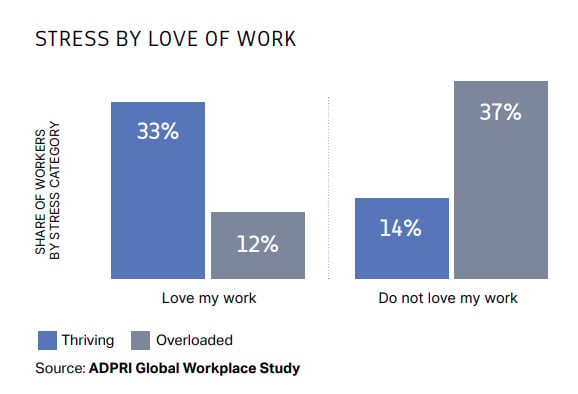
People who thrive in times of stress are more likely to be:6
Fully engaged on the job by 21X.
Highly resilient by 20X.
Employees feeling work pressure as “eustress” (good stress) are “Thriving”.6
— More engaged, more resilient, and less likely to quit their jobs.
— % who love their work and thrive is about the same across all organization levels.
Employees feeling work pressure as “distress” (bad stress) are “Overloaded”.6
— Causes them to shut down in every category of worker well-being.
— 10 times more likely to say they have plans to leave their organization.
Improving competence of supervisors and nimbly resilient culture solves the majority of distress and contributes greatly to eustress.
Employee experience infrastructure managed by Human Resources spans recruiting, hiring, onboarding, compensating, developing, reviewing, rewarding, promoting, exiting, and ethics and regulatory compliance. See these 5 guides to improving the employee experience infrastructure:
1. Why Customer Experience Excellence Requires HR Engagement, ClearAction.
2. How Human Resources Can Add Value to Customer Experience Excellence, ClearAction.
3. 5 Keys to Employee Engagement in Customer Experience, ClearAction.
4. 24 Ways 2024 Customer Experience is Smarter: CX = EX, CustomerThink.
5. Customer-Centered Business: 10 Keys to Organic Growth, ClearAction.
Conclusion
Every employee is vital to customer experience and maximizing value, with no exceptions.
In respect of customers funding salaries, budgets, and profit-sharing, employee experience design should be within the context of your high-potential customers’ top priorities and end-to-end journey expectations.
Costs of disengaged employees are nearly 3X higher than risks of lost revenue due to poor customer experiences. When you factor in higher inflation and interest rates, and so on, disengaged employees are clearly the top obstacle to reaching your potential in both customer experience excellence and business growth.
Trends in employee engagement are in tandem with trends in customer experience quality. Although there is much progress to be celebrated, both EX and CX are very immature. Companies excelling in top maturity levels for CX or EX are in the single-digit percentages. No meaningful changes are noted over the past 10+ years in the CX index, customers’ trust of companies, or customer-obsessed culture.
This stagnation calls urgently for a totally different approach to aligning and nurturing employee experience and customer experience. Instead of directly focusing on HR infrastructure, customer touchpoints, and specific engagement of employees and customers, it is makes more sense to re-focus management of the business entirely on high-potentials’ expectations and nimble resilience.
Studies by ADP, Gallup, OC Tanner, Forrester, Qualtrics, Edelman, Business Roundtable, and others show enormous gains in trust, productivity, and longevity when customer-centered management prevails companywide. As customers are the hand that feeds everyone, customers’ prosperity is your path to much greater prosperity.
1 The Strengths, Weaknesses and Blind Spots of Managers, Gallup, May 28, 2024.
2 State of the Global Workforce: 2023 Report, Gallup.
3 What is Employee Engagement and How Do You Improve It? Gallup.
4 Countries by GDP, World Population Review, 2024.
5 U.S. Engagement Hits 11-Year Low, Gallup, April 10, 2024.
6 Today at Work, ADP, March 2024.
7 Today at Work, ADP, September 2023.
8 Inflation is No Longer at a 40-Year High, BankRate, May 15, 2024.
9 Inflation and Prices, Econofact, February 12, 2024.
10 Forrester’s 2024 Australia CX Index: Overall CX Quality In Australia Continues To Decline, Forrester, June 4, 2024.
11 US CX Quality Falls For An Unprecedented Second Consecutive Year, Forrester, June 2023.
12 Rethinking Customer Experience Strategy: Forrester’s 2022 CX Index Dropped to 2020 Performance, CustomerThink, July 2022.
13 Consumer Trust Continues to Decline, Survey Finds, Qualtrics, January 11, 2024.
14 Global Study: How Consumers Choose Which Company to Buy From, Qualtrics, April 12, 2024.
15 Global Business Buyers Rank Competence, Consistency, And Dependability As Their Top Trust Levers, Forrester, January 8, 2024.
16 Forrester Announces North American Recipients Of Its 2024 Customer Obsession Awards, May 14, 2024.
17 Forrester Announces The EMEA Recipient Of Its 2024 Customer-Obsessed Enterprise Award, May 15, 2024.
18 2024 Edelman Trust Barometer: Innovation in Peril, Edelman, 2024.
19 $3.7 Trillion of 2024 Global Sales are at Risk Due to Bad Customer Experiences, Qualtrics XM Institute, February 1, 2024.
20 2024 Global Culture Report, O.C. Tanner Institute.
This article is the third in a five-part series:
1. Customer Experience ROI Handbook: What is CX ROI?
2. CX ROI Handbook: Proving CX Value to Executives
3. CX ROI Handbook: Connecting Employee Experience and Customer Experience ROI
4. CX ROI Handbook: Business Outcomes and Customer Outcomes (August)
5. CX ROI Handbook: CX Dashboards and Compensation (October)
Images licensed to ClearAction Continuum by Shutterstock.



